PPDI5039 - InsCorp Digitization Project: Report, Skills & Models
VerifiedAdded on 2023/06/14
|9
|3081
|369
Project
AI Summary
This project report details the InsCorp digitization project, which aimed to automate insurance claims processing. It explores the preparation and implementation phases, highlighting the use of a simulation to identify gaps addressed by four teams: Digitizing, Payments, Internal, and Customer. The report discusses transdisciplinary models applied, emphasizing the integration of project management, contextual theories, educational design, technical knowledge, and evaluation. It also examines the skills developed by team members, including negotiation, communication, change management, and system architecture knowledge. The analysis evaluates the learning objectives achieved, such as team work, problem solving, time management, data analysis, and communication effectiveness, supported by a portfolio of evidence including log books and critical incident diaries.
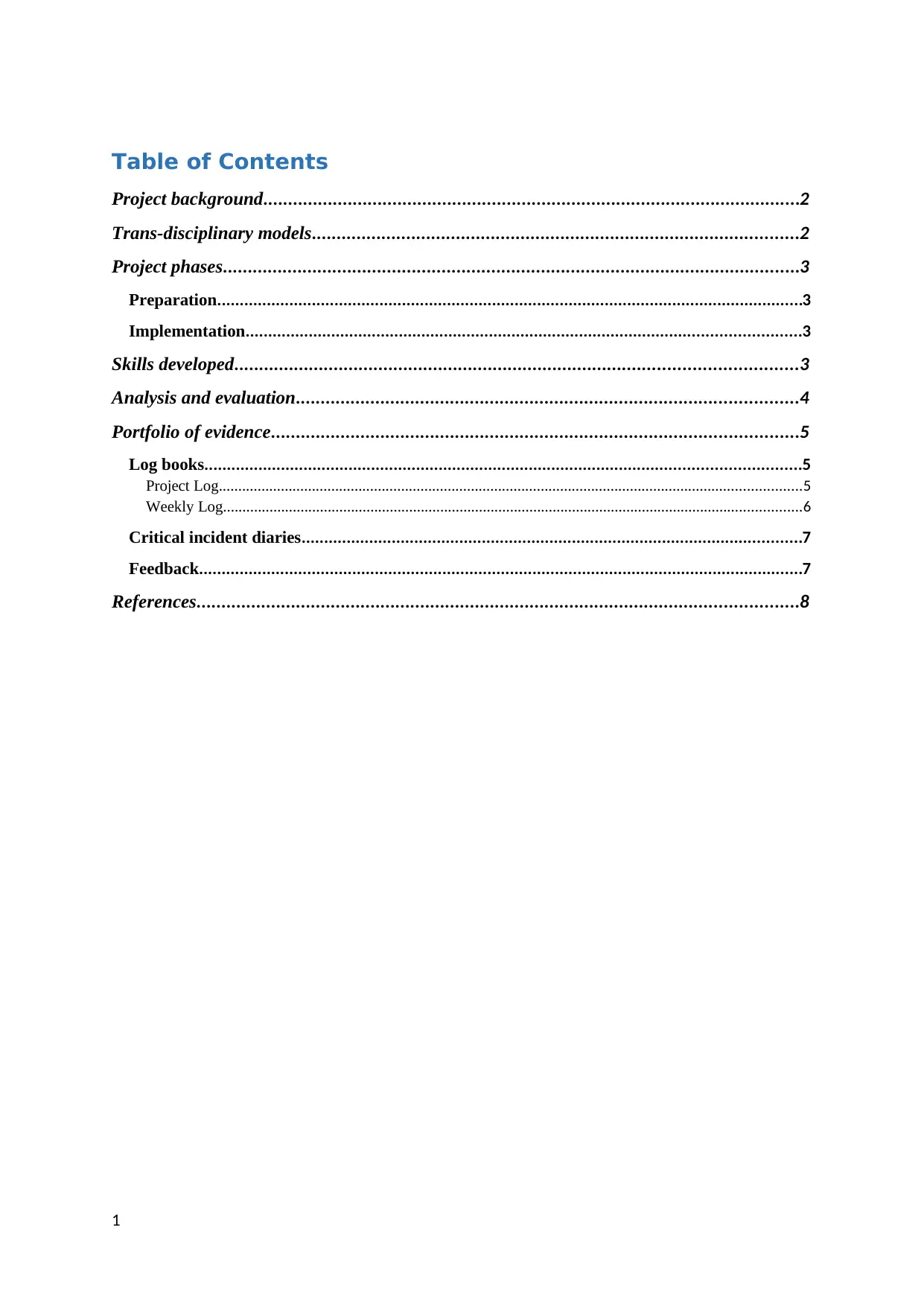
Table of Contents
Project background............................................................................................................2
Trans-disciplinary models..................................................................................................2
Project phases....................................................................................................................3
Preparation..................................................................................................................................3
Implementation...........................................................................................................................3
Skills developed.................................................................................................................3
Analysis and evaluation.....................................................................................................4
Portfolio of evidence..........................................................................................................5
Log books....................................................................................................................................5
Project Log......................................................................................................................................................5
Weekly Log.....................................................................................................................................................6
Critical incident diaries...............................................................................................................7
Feedback......................................................................................................................................7
References.........................................................................................................................8
1
Project background............................................................................................................2
Trans-disciplinary models..................................................................................................2
Project phases....................................................................................................................3
Preparation..................................................................................................................................3
Implementation...........................................................................................................................3
Skills developed.................................................................................................................3
Analysis and evaluation.....................................................................................................4
Portfolio of evidence..........................................................................................................5
Log books....................................................................................................................................5
Project Log......................................................................................................................................................5
Weekly Log.....................................................................................................................................................6
Critical incident diaries...............................................................................................................7
Feedback......................................................................................................................................7
References.........................................................................................................................8
1
Paraphrase This Document
Need a fresh take? Get an instant paraphrase of this document with our AI Paraphraser
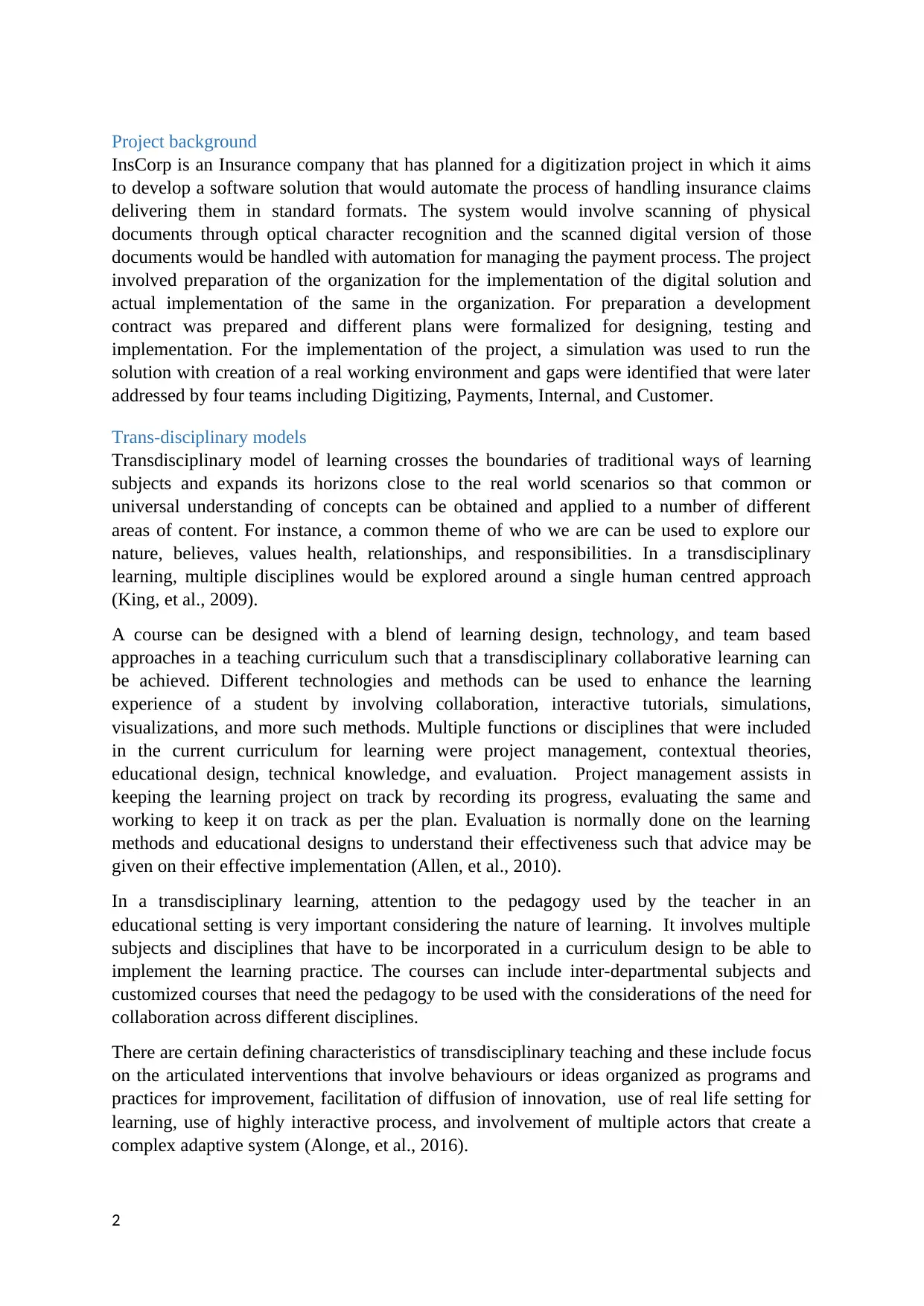
Project background
InsCorp is an Insurance company that has planned for a digitization project in which it aims
to develop a software solution that would automate the process of handling insurance claims
delivering them in standard formats. The system would involve scanning of physical
documents through optical character recognition and the scanned digital version of those
documents would be handled with automation for managing the payment process. The project
involved preparation of the organization for the implementation of the digital solution and
actual implementation of the same in the organization. For preparation a development
contract was prepared and different plans were formalized for designing, testing and
implementation. For the implementation of the project, a simulation was used to run the
solution with creation of a real working environment and gaps were identified that were later
addressed by four teams including Digitizing, Payments, Internal, and Customer.
Trans-disciplinary models
Transdisciplinary model of learning crosses the boundaries of traditional ways of learning
subjects and expands its horizons close to the real world scenarios so that common or
universal understanding of concepts can be obtained and applied to a number of different
areas of content. For instance, a common theme of who we are can be used to explore our
nature, believes, values health, relationships, and responsibilities. In a transdisciplinary
learning, multiple disciplines would be explored around a single human centred approach
(King, et al., 2009).
A course can be designed with a blend of learning design, technology, and team based
approaches in a teaching curriculum such that a transdisciplinary collaborative learning can
be achieved. Different technologies and methods can be used to enhance the learning
experience of a student by involving collaboration, interactive tutorials, simulations,
visualizations, and more such methods. Multiple functions or disciplines that were included
in the current curriculum for learning were project management, contextual theories,
educational design, technical knowledge, and evaluation. Project management assists in
keeping the learning project on track by recording its progress, evaluating the same and
working to keep it on track as per the plan. Evaluation is normally done on the learning
methods and educational designs to understand their effectiveness such that advice may be
given on their effective implementation (Allen, et al., 2010).
In a transdisciplinary learning, attention to the pedagogy used by the teacher in an
educational setting is very important considering the nature of learning. It involves multiple
subjects and disciplines that have to be incorporated in a curriculum design to be able to
implement the learning practice. The courses can include inter-departmental subjects and
customized courses that need the pedagogy to be used with the considerations of the need for
collaboration across different disciplines.
There are certain defining characteristics of transdisciplinary teaching and these include focus
on the articulated interventions that involve behaviours or ideas organized as programs and
practices for improvement, facilitation of diffusion of innovation, use of real life setting for
learning, use of highly interactive process, and involvement of multiple actors that create a
complex adaptive system (Alonge, et al., 2016).
2
InsCorp is an Insurance company that has planned for a digitization project in which it aims
to develop a software solution that would automate the process of handling insurance claims
delivering them in standard formats. The system would involve scanning of physical
documents through optical character recognition and the scanned digital version of those
documents would be handled with automation for managing the payment process. The project
involved preparation of the organization for the implementation of the digital solution and
actual implementation of the same in the organization. For preparation a development
contract was prepared and different plans were formalized for designing, testing and
implementation. For the implementation of the project, a simulation was used to run the
solution with creation of a real working environment and gaps were identified that were later
addressed by four teams including Digitizing, Payments, Internal, and Customer.
Trans-disciplinary models
Transdisciplinary model of learning crosses the boundaries of traditional ways of learning
subjects and expands its horizons close to the real world scenarios so that common or
universal understanding of concepts can be obtained and applied to a number of different
areas of content. For instance, a common theme of who we are can be used to explore our
nature, believes, values health, relationships, and responsibilities. In a transdisciplinary
learning, multiple disciplines would be explored around a single human centred approach
(King, et al., 2009).
A course can be designed with a blend of learning design, technology, and team based
approaches in a teaching curriculum such that a transdisciplinary collaborative learning can
be achieved. Different technologies and methods can be used to enhance the learning
experience of a student by involving collaboration, interactive tutorials, simulations,
visualizations, and more such methods. Multiple functions or disciplines that were included
in the current curriculum for learning were project management, contextual theories,
educational design, technical knowledge, and evaluation. Project management assists in
keeping the learning project on track by recording its progress, evaluating the same and
working to keep it on track as per the plan. Evaluation is normally done on the learning
methods and educational designs to understand their effectiveness such that advice may be
given on their effective implementation (Allen, et al., 2010).
In a transdisciplinary learning, attention to the pedagogy used by the teacher in an
educational setting is very important considering the nature of learning. It involves multiple
subjects and disciplines that have to be incorporated in a curriculum design to be able to
implement the learning practice. The courses can include inter-departmental subjects and
customized courses that need the pedagogy to be used with the considerations of the need for
collaboration across different disciplines.
There are certain defining characteristics of transdisciplinary teaching and these include focus
on the articulated interventions that involve behaviours or ideas organized as programs and
practices for improvement, facilitation of diffusion of innovation, use of real life setting for
learning, use of highly interactive process, and involvement of multiple actors that create a
complex adaptive system (Alonge, et al., 2016).
2
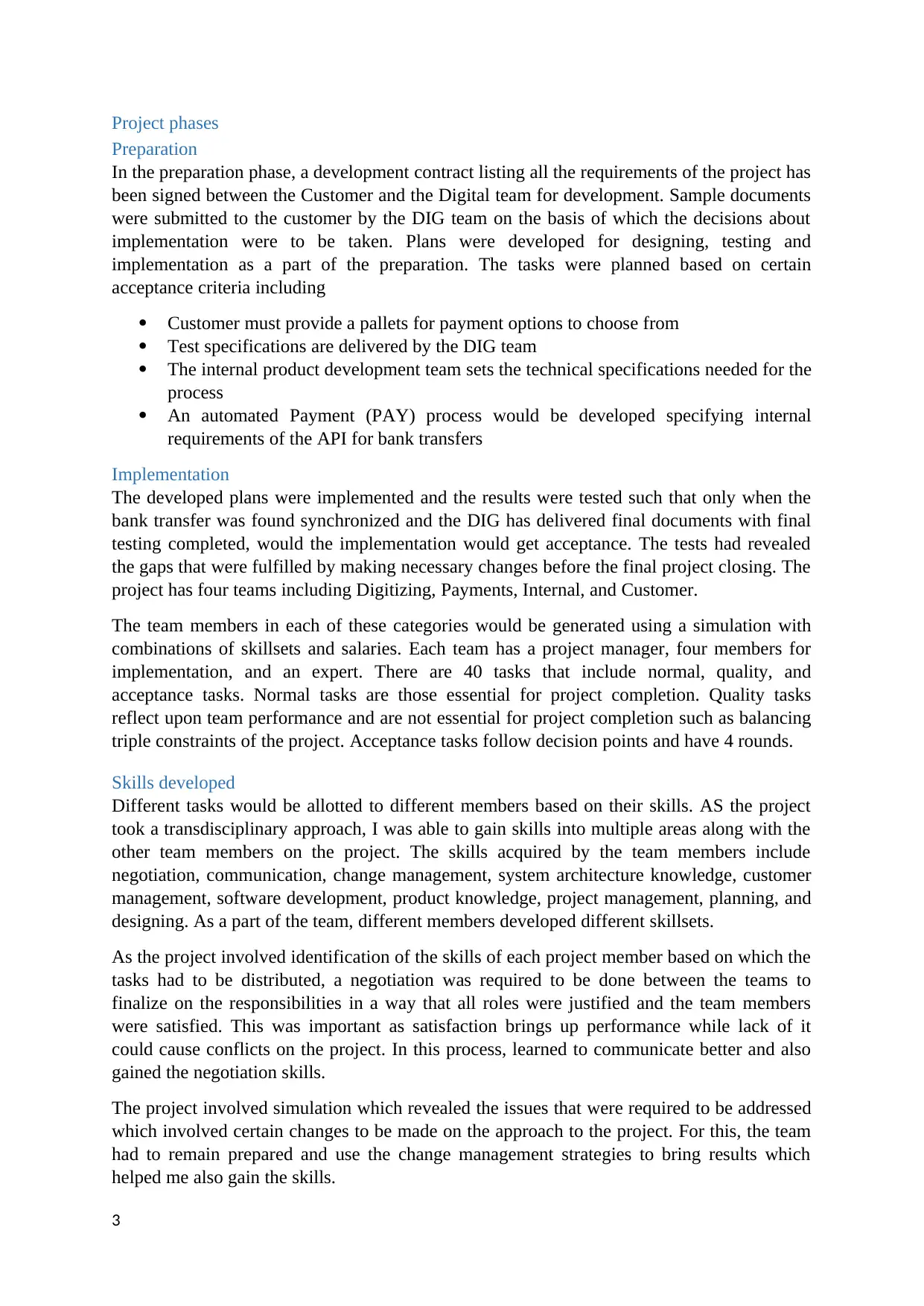
Project phases
Preparation
In the preparation phase, a development contract listing all the requirements of the project has
been signed between the Customer and the Digital team for development. Sample documents
were submitted to the customer by the DIG team on the basis of which the decisions about
implementation were to be taken. Plans were developed for designing, testing and
implementation as a part of the preparation. The tasks were planned based on certain
acceptance criteria including
Customer must provide a pallets for payment options to choose from
Test specifications are delivered by the DIG team
The internal product development team sets the technical specifications needed for the
process
An automated Payment (PAY) process would be developed specifying internal
requirements of the API for bank transfers
Implementation
The developed plans were implemented and the results were tested such that only when the
bank transfer was found synchronized and the DIG has delivered final documents with final
testing completed, would the implementation would get acceptance. The tests had revealed
the gaps that were fulfilled by making necessary changes before the final project closing. The
project has four teams including Digitizing, Payments, Internal, and Customer.
The team members in each of these categories would be generated using a simulation with
combinations of skillsets and salaries. Each team has a project manager, four members for
implementation, and an expert. There are 40 tasks that include normal, quality, and
acceptance tasks. Normal tasks are those essential for project completion. Quality tasks
reflect upon team performance and are not essential for project completion such as balancing
triple constraints of the project. Acceptance tasks follow decision points and have 4 rounds.
Skills developed
Different tasks would be allotted to different members based on their skills. AS the project
took a transdisciplinary approach, I was able to gain skills into multiple areas along with the
other team members on the project. The skills acquired by the team members include
negotiation, communication, change management, system architecture knowledge, customer
management, software development, product knowledge, project management, planning, and
designing. As a part of the team, different members developed different skillsets.
As the project involved identification of the skills of each project member based on which the
tasks had to be distributed, a negotiation was required to be done between the teams to
finalize on the responsibilities in a way that all roles were justified and the team members
were satisfied. This was important as satisfaction brings up performance while lack of it
could cause conflicts on the project. In this process, learned to communicate better and also
gained the negotiation skills.
The project involved simulation which revealed the issues that were required to be addressed
which involved certain changes to be made on the approach to the project. For this, the team
had to remain prepared and use the change management strategies to bring results which
helped me also gain the skills.
3
Preparation
In the preparation phase, a development contract listing all the requirements of the project has
been signed between the Customer and the Digital team for development. Sample documents
were submitted to the customer by the DIG team on the basis of which the decisions about
implementation were to be taken. Plans were developed for designing, testing and
implementation as a part of the preparation. The tasks were planned based on certain
acceptance criteria including
Customer must provide a pallets for payment options to choose from
Test specifications are delivered by the DIG team
The internal product development team sets the technical specifications needed for the
process
An automated Payment (PAY) process would be developed specifying internal
requirements of the API for bank transfers
Implementation
The developed plans were implemented and the results were tested such that only when the
bank transfer was found synchronized and the DIG has delivered final documents with final
testing completed, would the implementation would get acceptance. The tests had revealed
the gaps that were fulfilled by making necessary changes before the final project closing. The
project has four teams including Digitizing, Payments, Internal, and Customer.
The team members in each of these categories would be generated using a simulation with
combinations of skillsets and salaries. Each team has a project manager, four members for
implementation, and an expert. There are 40 tasks that include normal, quality, and
acceptance tasks. Normal tasks are those essential for project completion. Quality tasks
reflect upon team performance and are not essential for project completion such as balancing
triple constraints of the project. Acceptance tasks follow decision points and have 4 rounds.
Skills developed
Different tasks would be allotted to different members based on their skills. AS the project
took a transdisciplinary approach, I was able to gain skills into multiple areas along with the
other team members on the project. The skills acquired by the team members include
negotiation, communication, change management, system architecture knowledge, customer
management, software development, product knowledge, project management, planning, and
designing. As a part of the team, different members developed different skillsets.
As the project involved identification of the skills of each project member based on which the
tasks had to be distributed, a negotiation was required to be done between the teams to
finalize on the responsibilities in a way that all roles were justified and the team members
were satisfied. This was important as satisfaction brings up performance while lack of it
could cause conflicts on the project. In this process, learned to communicate better and also
gained the negotiation skills.
The project involved simulation which revealed the issues that were required to be addressed
which involved certain changes to be made on the approach to the project. For this, the team
had to remain prepared and use the change management strategies to bring results which
helped me also gain the skills.
3
⊘ This is a preview!⊘
Do you want full access?
Subscribe today to unlock all pages.

Trusted by 1+ million students worldwide
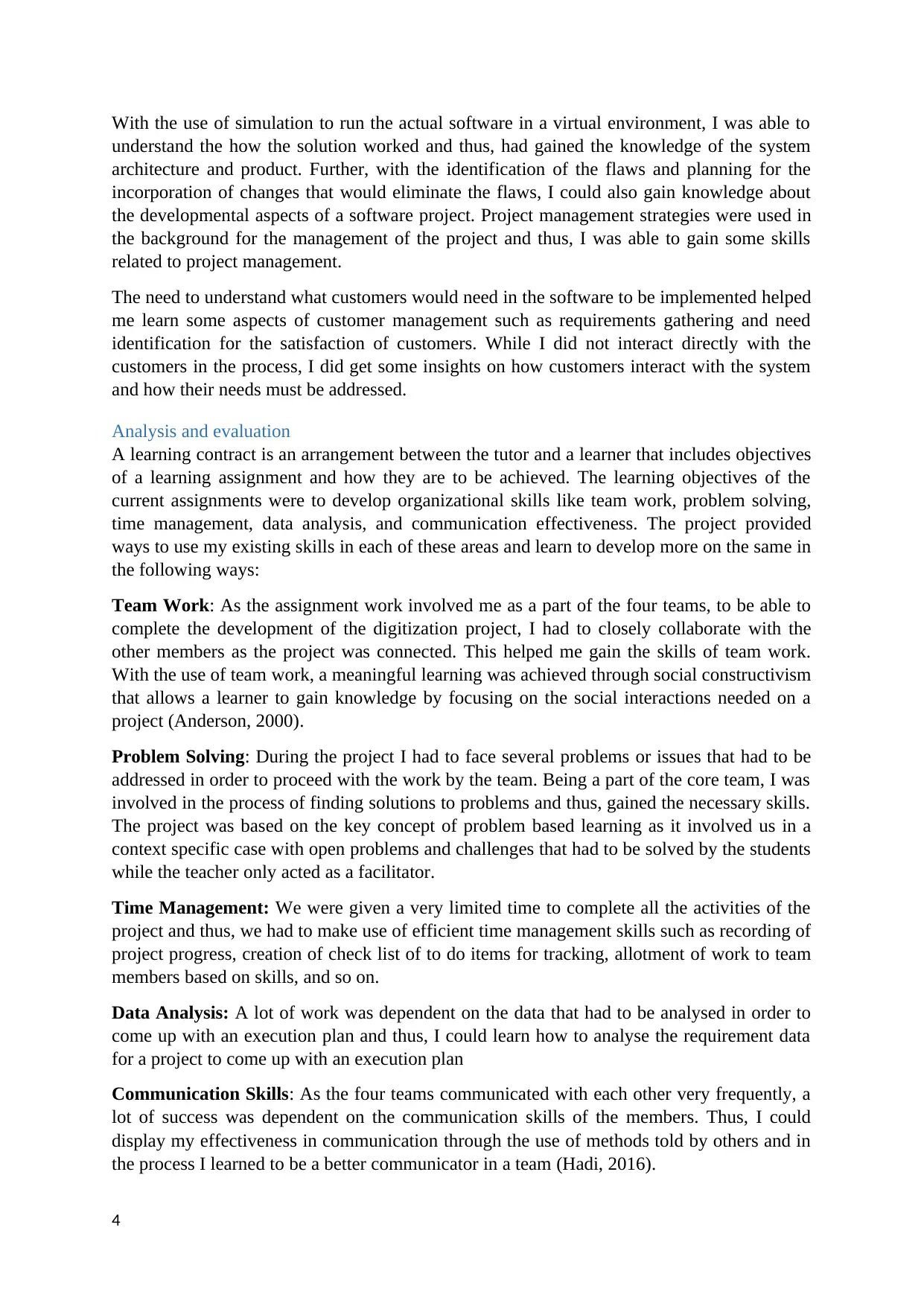
With the use of simulation to run the actual software in a virtual environment, I was able to
understand the how the solution worked and thus, had gained the knowledge of the system
architecture and product. Further, with the identification of the flaws and planning for the
incorporation of changes that would eliminate the flaws, I could also gain knowledge about
the developmental aspects of a software project. Project management strategies were used in
the background for the management of the project and thus, I was able to gain some skills
related to project management.
The need to understand what customers would need in the software to be implemented helped
me learn some aspects of customer management such as requirements gathering and need
identification for the satisfaction of customers. While I did not interact directly with the
customers in the process, I did get some insights on how customers interact with the system
and how their needs must be addressed.
Analysis and evaluation
A learning contract is an arrangement between the tutor and a learner that includes objectives
of a learning assignment and how they are to be achieved. The learning objectives of the
current assignments were to develop organizational skills like team work, problem solving,
time management, data analysis, and communication effectiveness. The project provided
ways to use my existing skills in each of these areas and learn to develop more on the same in
the following ways:
Team Work: As the assignment work involved me as a part of the four teams, to be able to
complete the development of the digitization project, I had to closely collaborate with the
other members as the project was connected. This helped me gain the skills of team work.
With the use of team work, a meaningful learning was achieved through social constructivism
that allows a learner to gain knowledge by focusing on the social interactions needed on a
project (Anderson, 2000).
Problem Solving: During the project I had to face several problems or issues that had to be
addressed in order to proceed with the work by the team. Being a part of the core team, I was
involved in the process of finding solutions to problems and thus, gained the necessary skills.
The project was based on the key concept of problem based learning as it involved us in a
context specific case with open problems and challenges that had to be solved by the students
while the teacher only acted as a facilitator.
Time Management: We were given a very limited time to complete all the activities of the
project and thus, we had to make use of efficient time management skills such as recording of
project progress, creation of check list of to do items for tracking, allotment of work to team
members based on skills, and so on.
Data Analysis: A lot of work was dependent on the data that had to be analysed in order to
come up with an execution plan and thus, I could learn how to analyse the requirement data
for a project to come up with an execution plan
Communication Skills: As the four teams communicated with each other very frequently, a
lot of success was dependent on the communication skills of the members. Thus, I could
display my effectiveness in communication through the use of methods told by others and in
the process I learned to be a better communicator in a team (Hadi, 2016).
4
understand the how the solution worked and thus, had gained the knowledge of the system
architecture and product. Further, with the identification of the flaws and planning for the
incorporation of changes that would eliminate the flaws, I could also gain knowledge about
the developmental aspects of a software project. Project management strategies were used in
the background for the management of the project and thus, I was able to gain some skills
related to project management.
The need to understand what customers would need in the software to be implemented helped
me learn some aspects of customer management such as requirements gathering and need
identification for the satisfaction of customers. While I did not interact directly with the
customers in the process, I did get some insights on how customers interact with the system
and how their needs must be addressed.
Analysis and evaluation
A learning contract is an arrangement between the tutor and a learner that includes objectives
of a learning assignment and how they are to be achieved. The learning objectives of the
current assignments were to develop organizational skills like team work, problem solving,
time management, data analysis, and communication effectiveness. The project provided
ways to use my existing skills in each of these areas and learn to develop more on the same in
the following ways:
Team Work: As the assignment work involved me as a part of the four teams, to be able to
complete the development of the digitization project, I had to closely collaborate with the
other members as the project was connected. This helped me gain the skills of team work.
With the use of team work, a meaningful learning was achieved through social constructivism
that allows a learner to gain knowledge by focusing on the social interactions needed on a
project (Anderson, 2000).
Problem Solving: During the project I had to face several problems or issues that had to be
addressed in order to proceed with the work by the team. Being a part of the core team, I was
involved in the process of finding solutions to problems and thus, gained the necessary skills.
The project was based on the key concept of problem based learning as it involved us in a
context specific case with open problems and challenges that had to be solved by the students
while the teacher only acted as a facilitator.
Time Management: We were given a very limited time to complete all the activities of the
project and thus, we had to make use of efficient time management skills such as recording of
project progress, creation of check list of to do items for tracking, allotment of work to team
members based on skills, and so on.
Data Analysis: A lot of work was dependent on the data that had to be analysed in order to
come up with an execution plan and thus, I could learn how to analyse the requirement data
for a project to come up with an execution plan
Communication Skills: As the four teams communicated with each other very frequently, a
lot of success was dependent on the communication skills of the members. Thus, I could
display my effectiveness in communication through the use of methods told by others and in
the process I learned to be a better communicator in a team (Hadi, 2016).
4
Paraphrase This Document
Need a fresh take? Get an instant paraphrase of this document with our AI Paraphraser
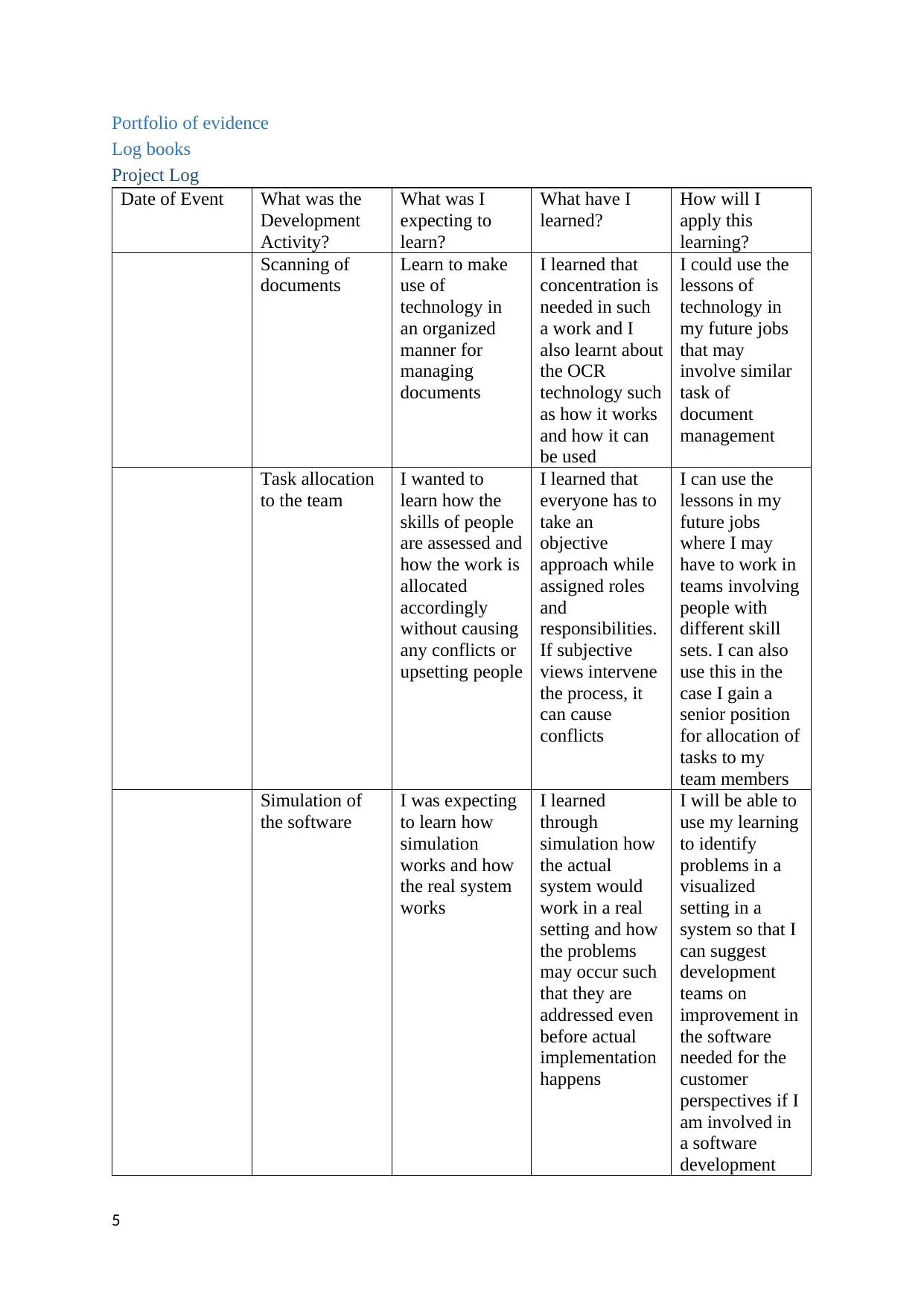
Portfolio of evidence
Log books
Project Log
Date of Event What was the
Development
Activity?
What was I
expecting to
learn?
What have I
learned?
How will I
apply this
learning?
Scanning of
documents
Learn to make
use of
technology in
an organized
manner for
managing
documents
I learned that
concentration is
needed in such
a work and I
also learnt about
the OCR
technology such
as how it works
and how it can
be used
I could use the
lessons of
technology in
my future jobs
that may
involve similar
task of
document
management
Task allocation
to the team
I wanted to
learn how the
skills of people
are assessed and
how the work is
allocated
accordingly
without causing
any conflicts or
upsetting people
I learned that
everyone has to
take an
objective
approach while
assigned roles
and
responsibilities.
If subjective
views intervene
the process, it
can cause
conflicts
I can use the
lessons in my
future jobs
where I may
have to work in
teams involving
people with
different skill
sets. I can also
use this in the
case I gain a
senior position
for allocation of
tasks to my
team members
Simulation of
the software
I was expecting
to learn how
simulation
works and how
the real system
works
I learned
through
simulation how
the actual
system would
work in a real
setting and how
the problems
may occur such
that they are
addressed even
before actual
implementation
happens
I will be able to
use my learning
to identify
problems in a
visualized
setting in a
system so that I
can suggest
development
teams on
improvement in
the software
needed for the
customer
perspectives if I
am involved in
a software
development
5
Log books
Project Log
Date of Event What was the
Development
Activity?
What was I
expecting to
learn?
What have I
learned?
How will I
apply this
learning?
Scanning of
documents
Learn to make
use of
technology in
an organized
manner for
managing
documents
I learned that
concentration is
needed in such
a work and I
also learnt about
the OCR
technology such
as how it works
and how it can
be used
I could use the
lessons of
technology in
my future jobs
that may
involve similar
task of
document
management
Task allocation
to the team
I wanted to
learn how the
skills of people
are assessed and
how the work is
allocated
accordingly
without causing
any conflicts or
upsetting people
I learned that
everyone has to
take an
objective
approach while
assigned roles
and
responsibilities.
If subjective
views intervene
the process, it
can cause
conflicts
I can use the
lessons in my
future jobs
where I may
have to work in
teams involving
people with
different skill
sets. I can also
use this in the
case I gain a
senior position
for allocation of
tasks to my
team members
Simulation of
the software
I was expecting
to learn how
simulation
works and how
the real system
works
I learned
through
simulation how
the actual
system would
work in a real
setting and how
the problems
may occur such
that they are
addressed even
before actual
implementation
happens
I will be able to
use my learning
to identify
problems in a
visualized
setting in a
system so that I
can suggest
development
teams on
improvement in
the software
needed for the
customer
perspectives if I
am involved in
a software
development
5
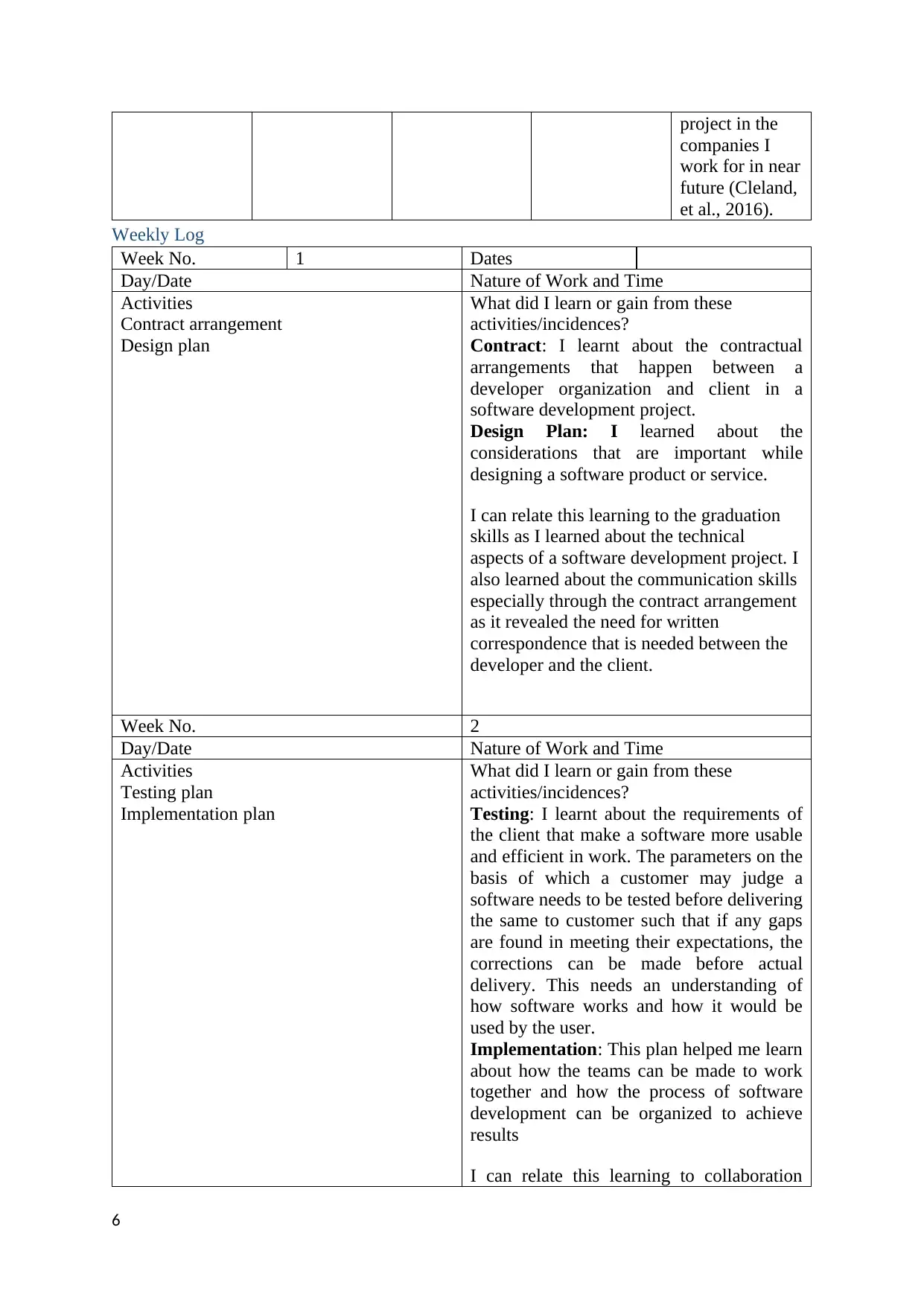
project in the
companies I
work for in near
future (Cleland,
et al., 2016).
Weekly Log
Week No. 1 Dates
Day/Date Nature of Work and Time
Activities
Contract arrangement
Design plan
What did I learn or gain from these
activities/incidences?
Contract: I learnt about the contractual
arrangements that happen between a
developer organization and client in a
software development project.
Design Plan: I learned about the
considerations that are important while
designing a software product or service.
I can relate this learning to the graduation
skills as I learned about the technical
aspects of a software development project. I
also learned about the communication skills
especially through the contract arrangement
as it revealed the need for written
correspondence that is needed between the
developer and the client.
Week No. 2
Day/Date Nature of Work and Time
Activities
Testing plan
Implementation plan
What did I learn or gain from these
activities/incidences?
Testing: I learnt about the requirements of
the client that make a software more usable
and efficient in work. The parameters on the
basis of which a customer may judge a
software needs to be tested before delivering
the same to customer such that if any gaps
are found in meeting their expectations, the
corrections can be made before actual
delivery. This needs an understanding of
how software works and how it would be
used by the user.
Implementation: This plan helped me learn
about how the teams can be made to work
together and how the process of software
development can be organized to achieve
results
I can relate this learning to collaboration
6
companies I
work for in near
future (Cleland,
et al., 2016).
Weekly Log
Week No. 1 Dates
Day/Date Nature of Work and Time
Activities
Contract arrangement
Design plan
What did I learn or gain from these
activities/incidences?
Contract: I learnt about the contractual
arrangements that happen between a
developer organization and client in a
software development project.
Design Plan: I learned about the
considerations that are important while
designing a software product or service.
I can relate this learning to the graduation
skills as I learned about the technical
aspects of a software development project. I
also learned about the communication skills
especially through the contract arrangement
as it revealed the need for written
correspondence that is needed between the
developer and the client.
Week No. 2
Day/Date Nature of Work and Time
Activities
Testing plan
Implementation plan
What did I learn or gain from these
activities/incidences?
Testing: I learnt about the requirements of
the client that make a software more usable
and efficient in work. The parameters on the
basis of which a customer may judge a
software needs to be tested before delivering
the same to customer such that if any gaps
are found in meeting their expectations, the
corrections can be made before actual
delivery. This needs an understanding of
how software works and how it would be
used by the user.
Implementation: This plan helped me learn
about how the teams can be made to work
together and how the process of software
development can be organized to achieve
results
I can relate this learning to collaboration
6
⊘ This is a preview!⊘
Do you want full access?
Subscribe today to unlock all pages.

Trusted by 1+ million students worldwide
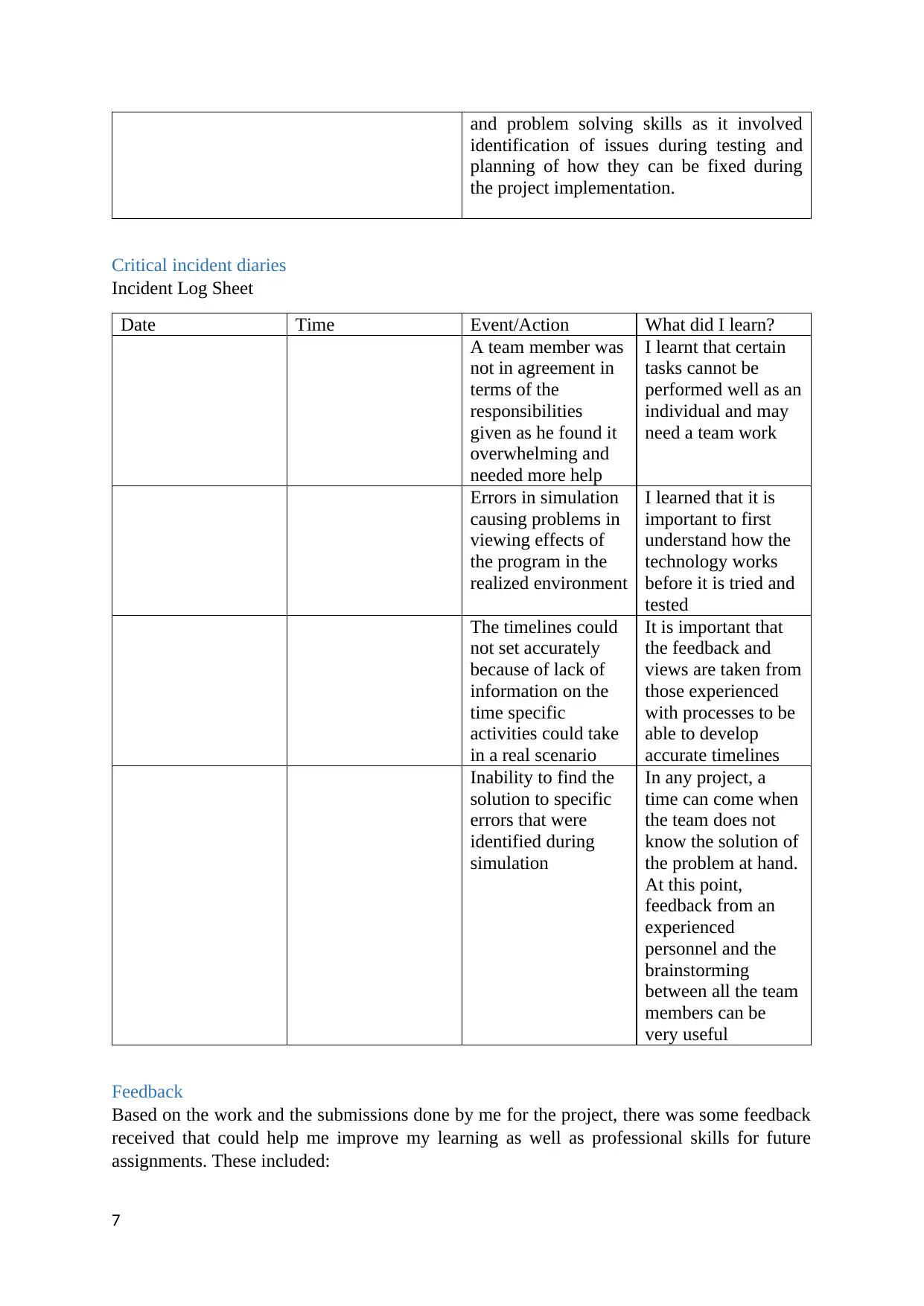
and problem solving skills as it involved
identification of issues during testing and
planning of how they can be fixed during
the project implementation.
Critical incident diaries
Incident Log Sheet
Date Time Event/Action What did I learn?
A team member was
not in agreement in
terms of the
responsibilities
given as he found it
overwhelming and
needed more help
I learnt that certain
tasks cannot be
performed well as an
individual and may
need a team work
Errors in simulation
causing problems in
viewing effects of
the program in the
realized environment
I learned that it is
important to first
understand how the
technology works
before it is tried and
tested
The timelines could
not set accurately
because of lack of
information on the
time specific
activities could take
in a real scenario
It is important that
the feedback and
views are taken from
those experienced
with processes to be
able to develop
accurate timelines
Inability to find the
solution to specific
errors that were
identified during
simulation
In any project, a
time can come when
the team does not
know the solution of
the problem at hand.
At this point,
feedback from an
experienced
personnel and the
brainstorming
between all the team
members can be
very useful
Feedback
Based on the work and the submissions done by me for the project, there was some feedback
received that could help me improve my learning as well as professional skills for future
assignments. These included:
7
identification of issues during testing and
planning of how they can be fixed during
the project implementation.
Critical incident diaries
Incident Log Sheet
Date Time Event/Action What did I learn?
A team member was
not in agreement in
terms of the
responsibilities
given as he found it
overwhelming and
needed more help
I learnt that certain
tasks cannot be
performed well as an
individual and may
need a team work
Errors in simulation
causing problems in
viewing effects of
the program in the
realized environment
I learned that it is
important to first
understand how the
technology works
before it is tried and
tested
The timelines could
not set accurately
because of lack of
information on the
time specific
activities could take
in a real scenario
It is important that
the feedback and
views are taken from
those experienced
with processes to be
able to develop
accurate timelines
Inability to find the
solution to specific
errors that were
identified during
simulation
In any project, a
time can come when
the team does not
know the solution of
the problem at hand.
At this point,
feedback from an
experienced
personnel and the
brainstorming
between all the team
members can be
very useful
Feedback
Based on the work and the submissions done by me for the project, there was some feedback
received that could help me improve my learning as well as professional skills for future
assignments. These included:
7
Paraphrase This Document
Need a fresh take? Get an instant paraphrase of this document with our AI Paraphraser
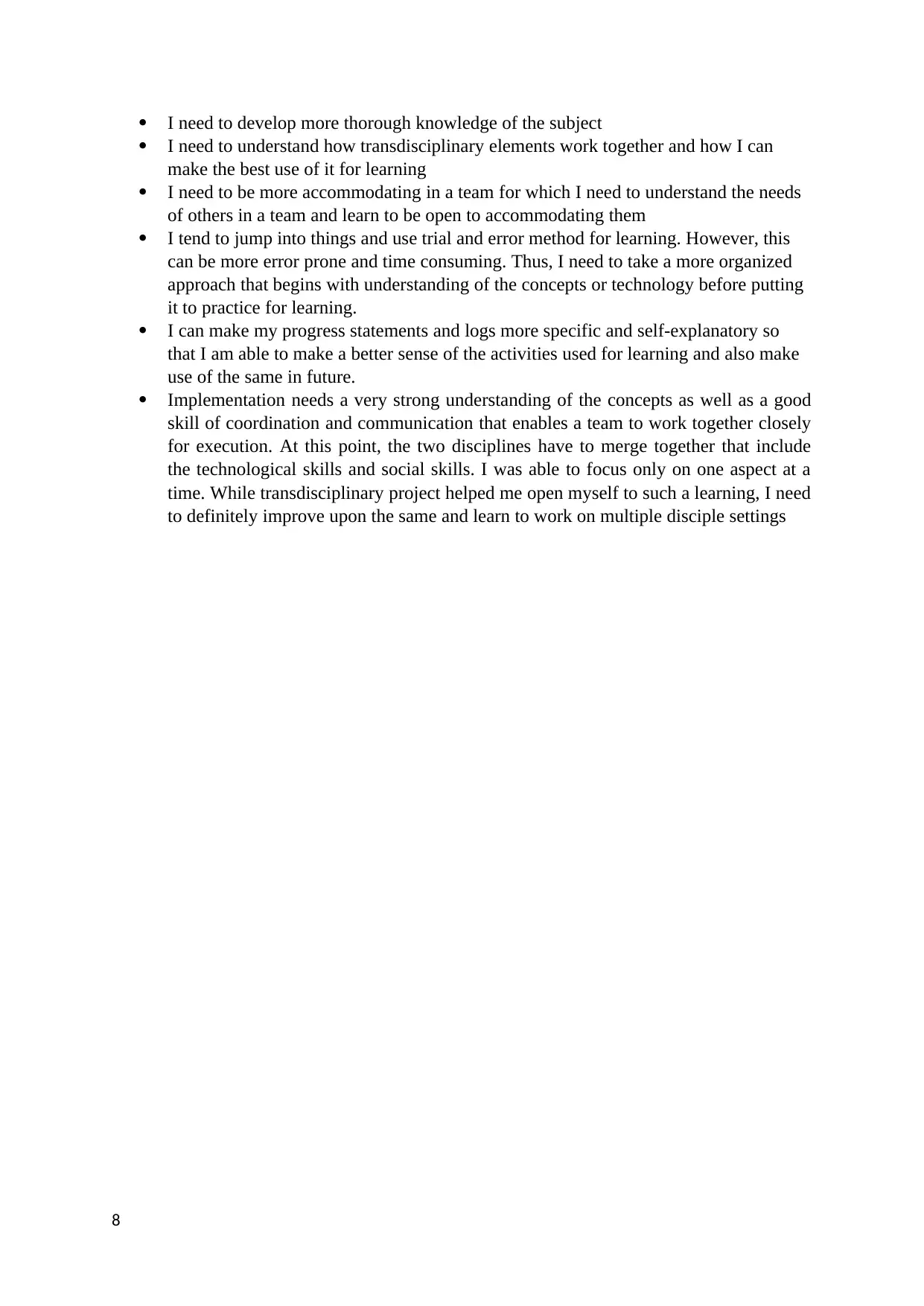
I need to develop more thorough knowledge of the subject
I need to understand how transdisciplinary elements work together and how I can
make the best use of it for learning
I need to be more accommodating in a team for which I need to understand the needs
of others in a team and learn to be open to accommodating them
I tend to jump into things and use trial and error method for learning. However, this
can be more error prone and time consuming. Thus, I need to take a more organized
approach that begins with understanding of the concepts or technology before putting
it to practice for learning.
I can make my progress statements and logs more specific and self-explanatory so
that I am able to make a better sense of the activities used for learning and also make
use of the same in future.
Implementation needs a very strong understanding of the concepts as well as a good
skill of coordination and communication that enables a team to work together closely
for execution. At this point, the two disciplines have to merge together that include
the technological skills and social skills. I was able to focus only on one aspect at a
time. While transdisciplinary project helped me open myself to such a learning, I need
to definitely improve upon the same and learn to work on multiple disciple settings
8
I need to understand how transdisciplinary elements work together and how I can
make the best use of it for learning
I need to be more accommodating in a team for which I need to understand the needs
of others in a team and learn to be open to accommodating them
I tend to jump into things and use trial and error method for learning. However, this
can be more error prone and time consuming. Thus, I need to take a more organized
approach that begins with understanding of the concepts or technology before putting
it to practice for learning.
I can make my progress statements and logs more specific and self-explanatory so
that I am able to make a better sense of the activities used for learning and also make
use of the same in future.
Implementation needs a very strong understanding of the concepts as well as a good
skill of coordination and communication that enables a team to work together closely
for execution. At this point, the two disciplines have to merge together that include
the technological skills and social skills. I was able to focus only on one aspect at a
time. While transdisciplinary project helped me open myself to such a learning, I need
to definitely improve upon the same and learn to work on multiple disciple settings
8
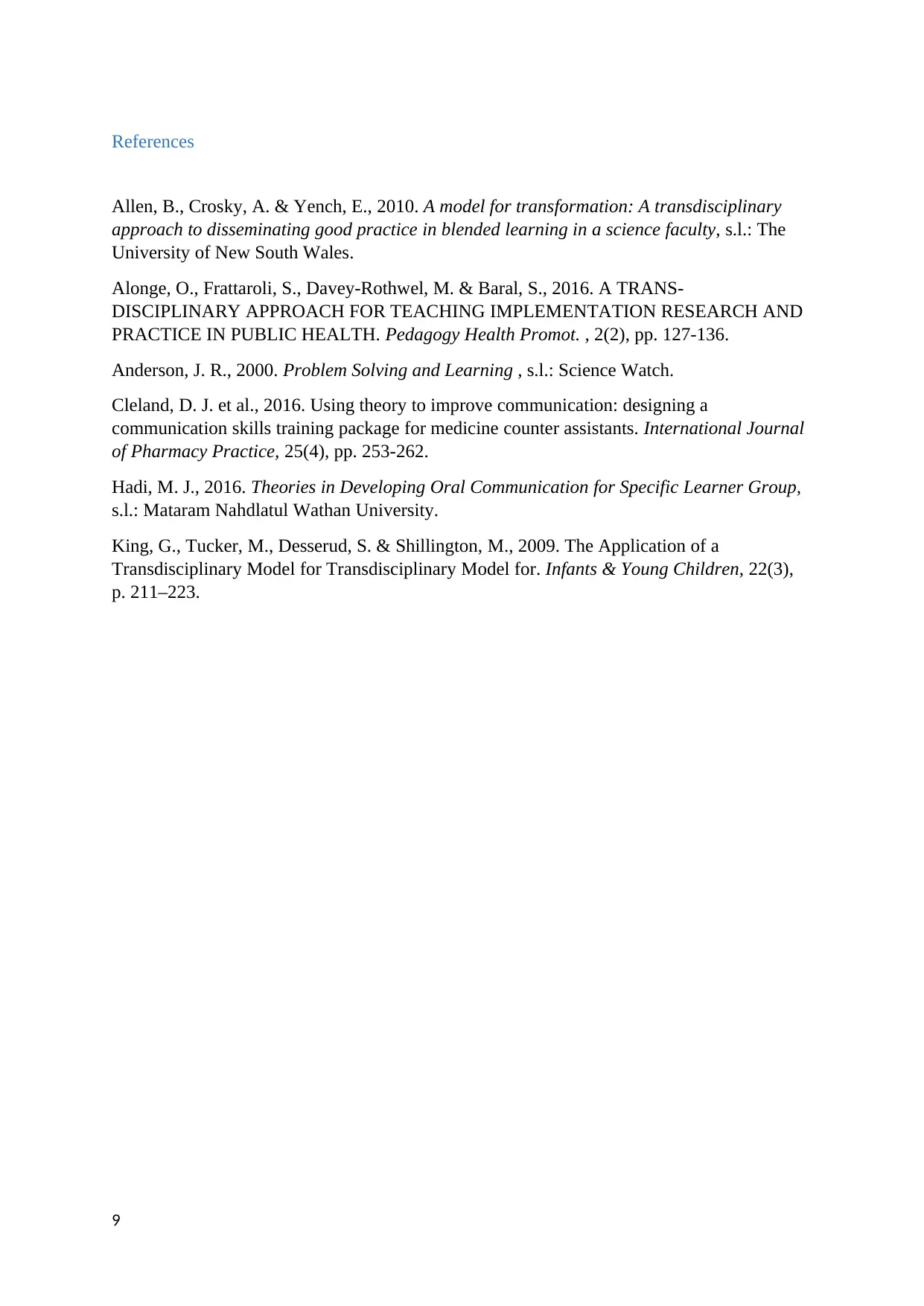
References
Allen, B., Crosky, A. & Yench, E., 2010. A model for transformation: A transdisciplinary
approach to disseminating good practice in blended learning in a science faculty, s.l.: The
University of New South Wales.
Alonge, O., Frattaroli, S., Davey-Rothwel, M. & Baral, S., 2016. A TRANS-
DISCIPLINARY APPROACH FOR TEACHING IMPLEMENTATION RESEARCH AND
PRACTICE IN PUBLIC HEALTH. Pedagogy Health Promot. , 2(2), pp. 127-136.
Anderson, J. R., 2000. Problem Solving and Learning , s.l.: Science Watch.
Cleland, D. J. et al., 2016. Using theory to improve communication: designing a
communication skills training package for medicine counter assistants. International Journal
of Pharmacy Practice, 25(4), pp. 253-262.
Hadi, M. J., 2016. Theories in Developing Oral Communication for Specific Learner Group,
s.l.: Mataram Nahdlatul Wathan University.
King, G., Tucker, M., Desserud, S. & Shillington, M., 2009. The Application of a
Transdisciplinary Model for Transdisciplinary Model for. Infants & Young Children, 22(3),
p. 211–223.
9
Allen, B., Crosky, A. & Yench, E., 2010. A model for transformation: A transdisciplinary
approach to disseminating good practice in blended learning in a science faculty, s.l.: The
University of New South Wales.
Alonge, O., Frattaroli, S., Davey-Rothwel, M. & Baral, S., 2016. A TRANS-
DISCIPLINARY APPROACH FOR TEACHING IMPLEMENTATION RESEARCH AND
PRACTICE IN PUBLIC HEALTH. Pedagogy Health Promot. , 2(2), pp. 127-136.
Anderson, J. R., 2000. Problem Solving and Learning , s.l.: Science Watch.
Cleland, D. J. et al., 2016. Using theory to improve communication: designing a
communication skills training package for medicine counter assistants. International Journal
of Pharmacy Practice, 25(4), pp. 253-262.
Hadi, M. J., 2016. Theories in Developing Oral Communication for Specific Learner Group,
s.l.: Mataram Nahdlatul Wathan University.
King, G., Tucker, M., Desserud, S. & Shillington, M., 2009. The Application of a
Transdisciplinary Model for Transdisciplinary Model for. Infants & Young Children, 22(3),
p. 211–223.
9
⊘ This is a preview!⊘
Do you want full access?
Subscribe today to unlock all pages.

Trusted by 1+ million students worldwide
1 out of 9
Your All-in-One AI-Powered Toolkit for Academic Success.
+13062052269
info@desklib.com
Available 24*7 on WhatsApp / Email
![[object Object]](/_next/static/media/star-bottom.7253800d.svg)
Unlock your academic potential
Copyright © 2020–2025 A2Z Services. All Rights Reserved. Developed and managed by ZUCOL.

